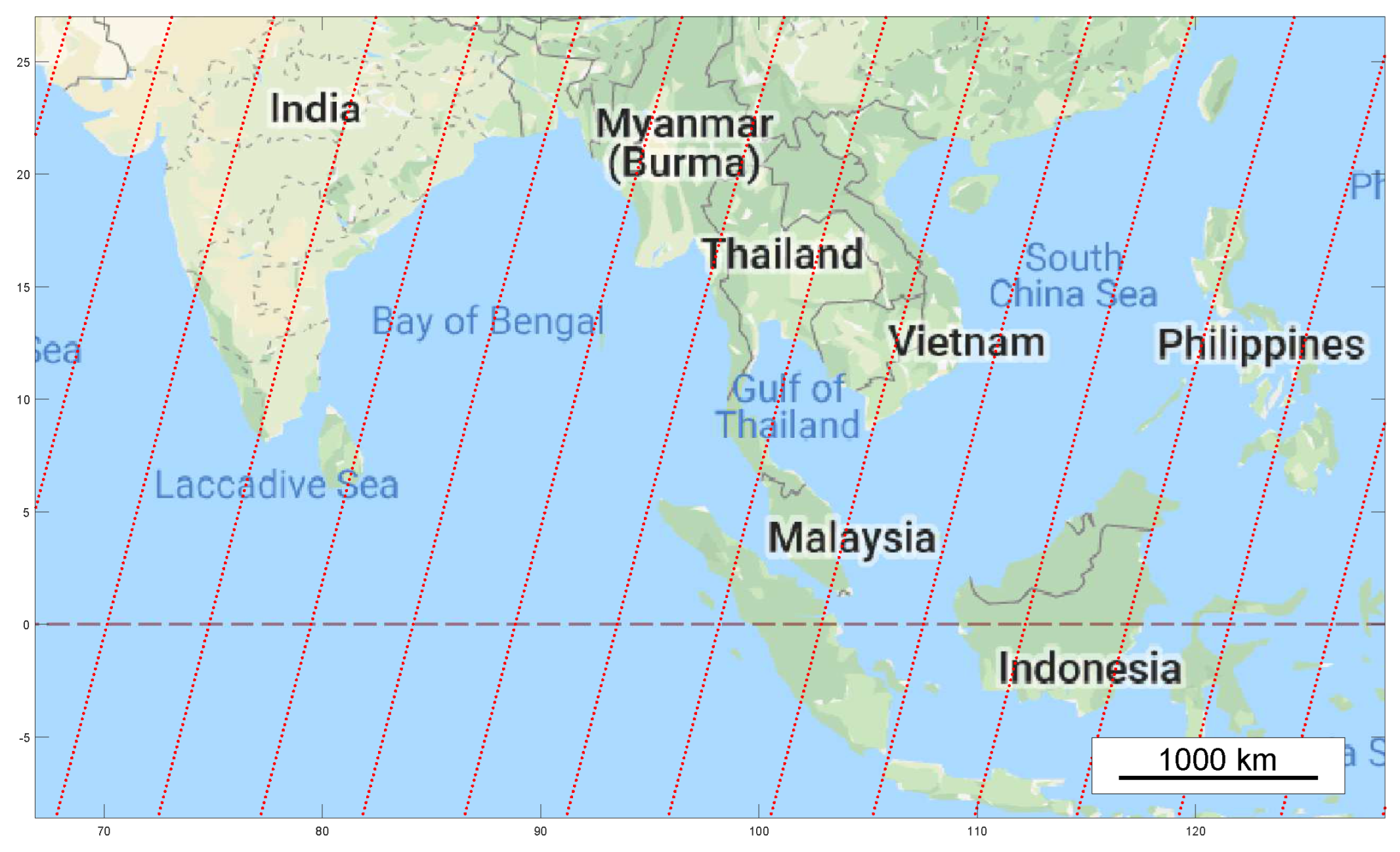Orbit Design for Thai Space Consortium Satellite †
Abstract
:1. Introduction
2. Reference Orbit and Design Methodology
2.1. Design of Revisiting Time
| Epoch Time | 1 January 2021 22:00:00.000 |
|---|---|
| semi-major axis (a) | 7008.4715082 (km) |
| eccentricity (e) | 0.001313349 |
| inclination (i) | 98.000640878 |
| right ascension of ascending node, RAAN () | |
| argument of perigee () | |
| mean anomaly (M) | |
| true anomaly () | |
| nodal period (P) | 5834.8051948 (s) |
2.2. Design of Orbital Parameters
2.2.1. Preliminary Analysis
2.2.2. Iterative Method
3. Results and Discussion
- Scenario of TSC satellite flying along the same ground track as THEOS2 main satellite and has a prior local solar of 30 min.
- Scenario of TSC satellite having 5 times faster revisiting time than THEOS2 main satellite.
3.1. Scenario 1
| Scenario 1 | Scenario 2 | |
|---|---|---|
| Epoch Time | 9 January 2025 21:30:00.000 UT1 | 1 January 2025 21:30:00.000 UT1 |
| semi-major axis (a) | 7008.474 (km) | 6827.726 (km) |
| eccentricity (e) | 0.001054258 | 0.001083911 |
| inclination (i) | 97.90756 | 97.21264 |
| right ascension of ascending node, RAAN () | ||
| argument of perigee () | ||
| mean anomaly (M) | − | − |
| true anomaly () | ||
| nodal period (P) | 5834.80519 (s) | 5610.38961 (s) |
3.2. Scenario 2

4. Conclusions
Author Contributions
Funding
Acknowledgments
Conflicts of Interest
References
- Boain, R.J. A-B-Cs of sun-synchronous orbit mission design. In Proceedings of the 14th AAS/AIAA Space Flight Mechanics Conference, Maui, HI, USA, 8–12 February 2004. [Google Scholar]
- Vallado, D.A. Mission Analysis. In Fundamentals of Astrodynamics and Applications; Microcosm Press: Cleveland, OH, USA, 2013; Chapter 11; pp. 837–939. [Google Scholar]
- Ravanbakhsh, A.; Franchini, S. System engineering approach to initial design of LEO remote sensing missions. In Proceedings of the 2013 6th International Conference on Recent Advances in Space Technologies (RAST), Istanbul, Turkey, 12–14 June 2013; pp. 659–664. [Google Scholar]
- Peter Fortescue, G.S.; Stark, J. Mission Analysis. In Spacecraft Systems Engineering; A John Wiley & Sons Ltd.: Hoboken, NJ, USA, 2011; Chapter 5; pp. 111–147. [Google Scholar]
- Blitzer, L. Nodal period of an earth satellite. AIAA J. 1964, 2, 1459–1460. [Google Scholar] [CrossRef]
- Cutting, E.; Frautnick, J.; Born, G. Orbit analysis for SEASAT-A. J. Astronaut. Sci. 1978, 26, 315–342. [Google Scholar]

© 2019 by the authors. Licensee MDPI, Basel, Switzerland. This article is an open access article distributed under the terms and conditions of the Creative Commons Attribution (CC BY) license (http://creativecommons.org/licenses/by/4.0/).
Share and Cite
Sreesawet, S.; Jaturat, S.; Channamsin, S. Orbit Design for Thai Space Consortium Satellite. Proceedings 2019, 39, 1. https://doi.org/10.3390/proceedings2019039001
Sreesawet S, Jaturat S, Channamsin S. Orbit Design for Thai Space Consortium Satellite. Proceedings. 2019; 39(1):1. https://doi.org/10.3390/proceedings2019039001
Chicago/Turabian StyleSreesawet, Suwat, Seksan Jaturat, and Sittiporn Channamsin. 2019. "Orbit Design for Thai Space Consortium Satellite" Proceedings 39, no. 1: 1. https://doi.org/10.3390/proceedings2019039001
APA StyleSreesawet, S., Jaturat, S., & Channamsin, S. (2019). Orbit Design for Thai Space Consortium Satellite. Proceedings, 39(1), 1. https://doi.org/10.3390/proceedings2019039001




